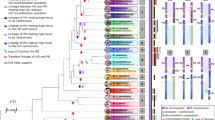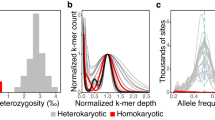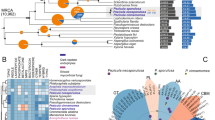Abstract
EXAMINATIONS have been made of the distribution of multiple-allelomorphic mating-type factors (m.t.f.) carried by basidiospores and produced by adjacent carpophores of higher fungi. The spatial distribution patterns found have been interpreted to provide evidence concerning the disposition of the mycelium giving rise to the sporophores and its genetieal homogeneity or heterogeneity1.
This is a preview of subscription content, access via your institution
Access options
Subscribe to this journal
Receive 51 print issues and online access
$199.00 per year
only $3.90 per issue
Buy this article
- Purchase on SpringerLink
- Instant access to full article PDF
Prices may be subject to local taxes which are calculated during checkout
Similar content being viewed by others
References
Burnett, J. H., and Partington, M., Proc. Roy. Soc. Edin., 26, 61 (1957).
Ramsbottom, J., Mushrooms and Toadstools (Collins, London, 1953).
Bayliss-Elliott, J. S., J. Econ. Biol., VI, 111 (1911).
Drew-Smith, J., J. Sports Turf. Res. Inst., 9, 1 (1957).
Day, P. R., in Incompatibility in Fungi, edit. by Esser, K., and Raper, J. R., 31 (Springer-Verlag, Berlin, 1965).
Ellinboe, A. H., in Incompatibility in Fungi, edit. by Esser, K., and Raper, J. R., 36 (Springer-Verlag, Berlin, 1965).
Burnett, J. H., in Incompatibility in Fungi, edit. by Esser, K., and Raper, J. R., Table 3, 105> (Springer-Verlag, Berlin, 1965).
Author information
Authors and Affiliations
Rights and permissions
About this article
Cite this article
BURNETT, J., EVANS, E. Genetical Homogeneity and the Stability of the Mating-type Factors of ‘Fairy Rings’ of Marasmius oreacdes. Nature 210, 1368–1369 (1966). https://doi.org/10.1038/2101368b0
Published:
Issue date:
DOI: https://doi.org/10.1038/2101368b0
This article is cited by
-
Process based modelling of plants–fungus interactions explains fairy ring types and dynamics
Scientific Reports (2023)



